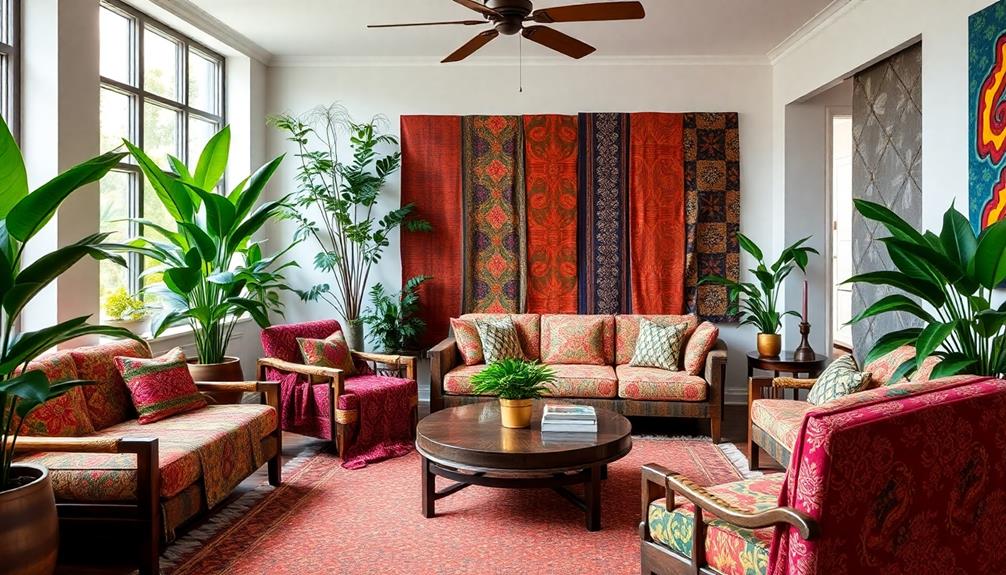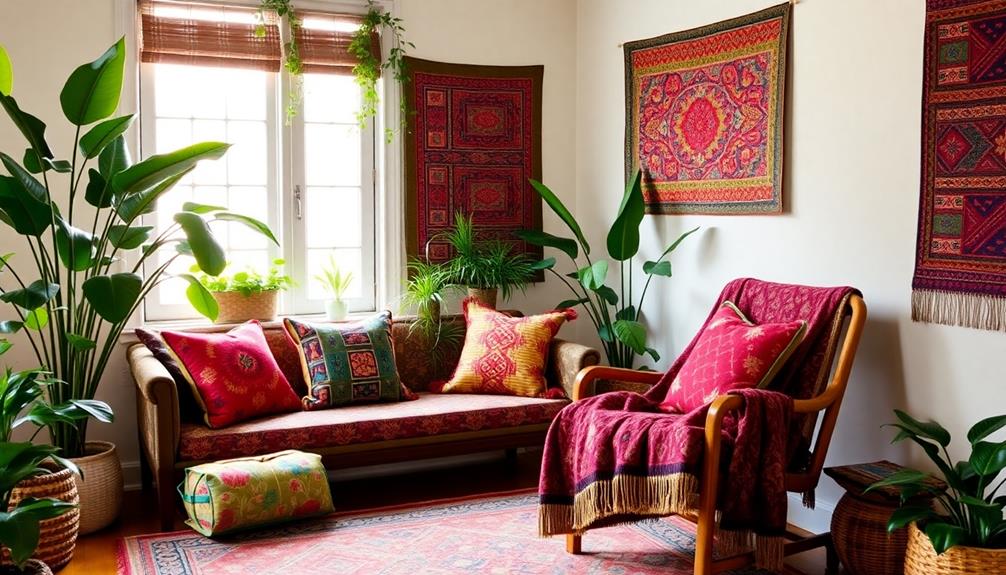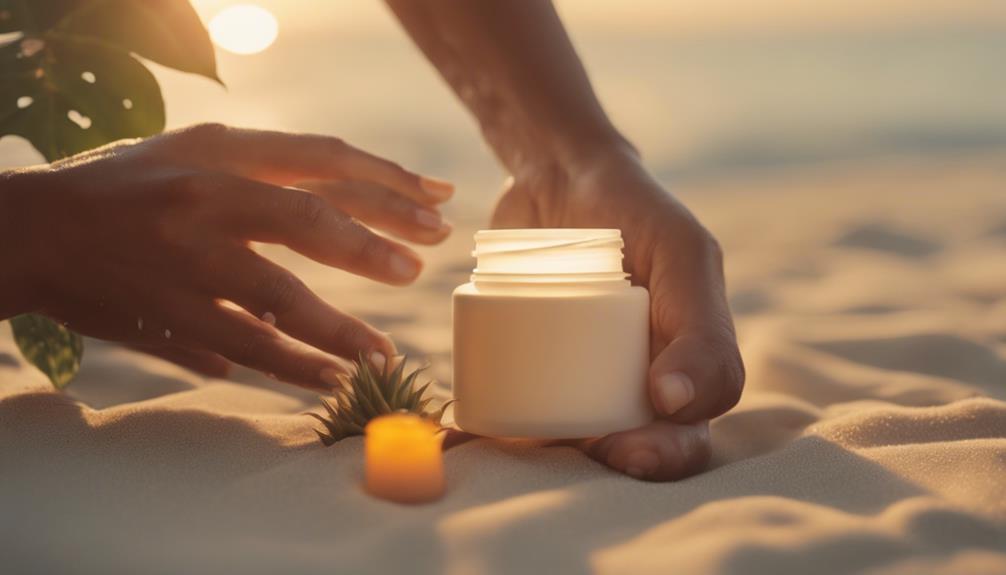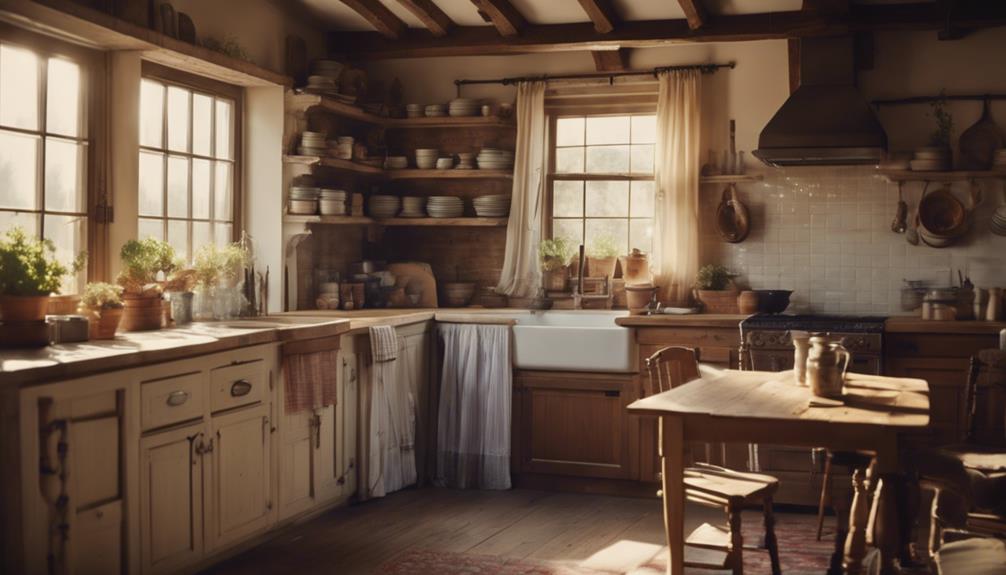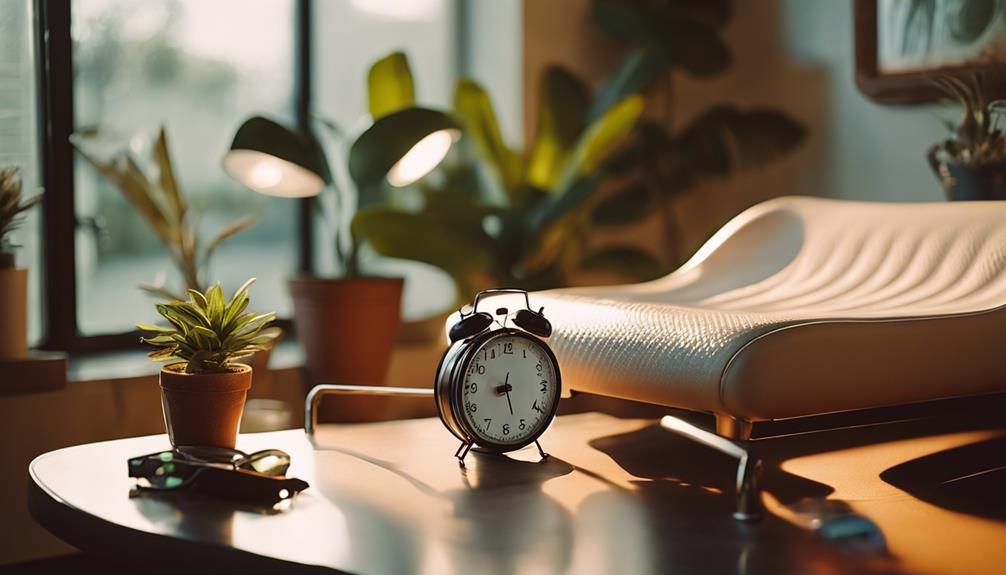Indonesian textiles are making a significant impact on modern interior design by combining deep-rooted cultural tradition and contemporary aesthetics. These textiles, including Batik and Ikat, highlight the intricate craftsmanship of more than 300 ethnic groups, elevating traditional fabrics into stunning decor pieces. Leading brands like Oerip and Mufit are leading the way in converting these textiles into trendy home accessories that appeal to today’s shoppers. This harmony not only enhances visual appeal but also narrates compelling stories of artisanship and eco-friendliness. Explore how these lively textiles are influencing global markets and reshaping decor trends through this thrilling evolution.
Key Takeaways
- Indonesian textiles, blending traditional techniques like Batik and Ikat with modern designs, create unique and stylish decor options for contemporary spaces.
- The vibrant colors and intricate patterns of Indonesian fabrics enhance home decor aesthetics, adding cultural richness to modern interior designs.
- Successful brands, such as Oerip and Mufit, modernize traditional textiles, appealing to a younger audience while preserving cultural narratives.
- Growing global demand for culturally-rich decor drives the integration of Indonesian textiles into mainstream design, reflecting a trend towards authenticity.
- Sustainability initiatives in the textile industry, including eco-friendly materials and fair trade practices, resonate with consumers seeking responsible decor choices.
Economic Impact of Textiles

Driving economic growth, the Indonesian textile industry plays an essential role in the nation's financial landscape. With projections indicating a rise from USD 13.83 billion in 2024 to USD 18.10 billion by 2029, it's clear the economic impact of textiles is significant.
This sector doesn't just contribute to GDP; it employs nearly 2 million people, providing essential livelihoods for families across Indonesia. Additionally, the revitalization of traditional crafts, such as weaving techniques used in traditional Indonesian housing, is contributing to the cultural richness of the textile industry.
In 2022, Indonesia's textile exports reached an impressive USD 12 billion, establishing the country as a major player in the global market. You'll appreciate the resilience of this industry, which is growing at an annual rate of 5.84%, even amid global economic challenges and fierce competition.
As the domestic middle class expands, consumer demand for textiles continues to drive innovation and growth within the industry. This rising demand isn't just enhancing production; it's also encouraging investments in sustainable practices and modern techniques.
Cultural Heritage and Craftsmanship
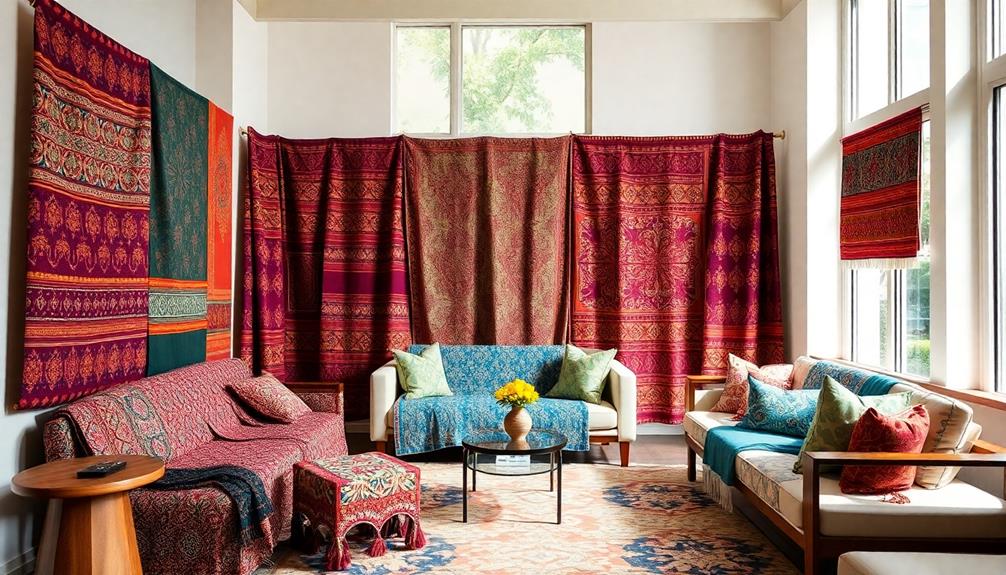
When you explore Indonesian textiles, you'll notice how traditional techniques are being revived in exciting ways.
These artisans blend age-old craftsmanship with modern designs, making each piece a unique addition to your decor. This fusion not only honors cultural heritage but also makes it relevant for today's style-savvy consumers.
Additionally, materials used often reflect the rich Indonesian cultural heritage, enhancing the narrative behind each textile piece.
This approach encourages appreciation for traditional craftsmanship while appealing to contemporary tastes.
Traditional Techniques Revived
Indonesian textiles aren't just fabrics; they embody a rich tapestry of cultural heritage and craftsmanship that continues to thrive today. Traditional textiles like Batik, Ikat, and Songket showcase intricate techniques that reflect the artistry of over 300 ethnic groups in the archipelago.
These methods aren't just about aesthetics; they tell stories and preserve cultural narratives that are significant for future generations. The use of vibrant colors and intricate patterns in these textiles enhances living spaces, making them a versatile choice for modern decor Indonesian Decorative Pillows.
The revival of traditional craftsmanship is essential as it emphasizes preserving these artistic techniques while appealing to modern consumers. Brands like Oerip Indonesia exemplify this revival by modernizing traditional textiles, making them affordable and stylish for younger generations.
This approach breaks stereotypes, encouraging a new appreciation for the depth and beauty of these fabrics. Batik, recognized by UNESCO as a Masterpiece of Oral and Intangible Heritage, highlights the cultural significance of these textiles on a global scale.
The use of gold-wrapped threads and intricate embroidery in these traditional textiles not only represents high craftsmanship but also embeds symbolic meanings that resonate deeply in modern decor. By embracing these techniques, you can enrich your space with a touch of Indonesia's vibrant heritage.
Fusion of Modern Designs
Blending tradition with innovation, the fusion of modern designs in Indonesian textiles creates a unique aesthetic that resonates with today's consumers. Brands like Oerip Indonesia are leading this charge, modernizing traditional fabrics like Batik and Ikat to appeal to Millennials and Gen-Z.
They're transforming these rich textiles into affordable, stylish garments that fit seamlessly into contemporary wardrobes. This approach mirrors the emphasis on traditional Indonesian style home decor, which incorporates natural materials and intricate designs, further enhancing the cultural significance of these textiles.
This fusion doesn't just stop at fashion; it extends into home decor, where modern textiles incorporating historical significance and innovative patterns tell a compelling story. By embracing these designs, you're not just enhancing your space; you're also celebrating a vibrant cultural heritage.
As the textile industry in Indonesia, valued at USD 13.83 billion in 2024, adapts to modern market demands, it preserves the artistry and craftsmanship inherent in these fabrics. Each piece you incorporate into your life honors cultural roots while appealing to current trends.
Modernization Challenges
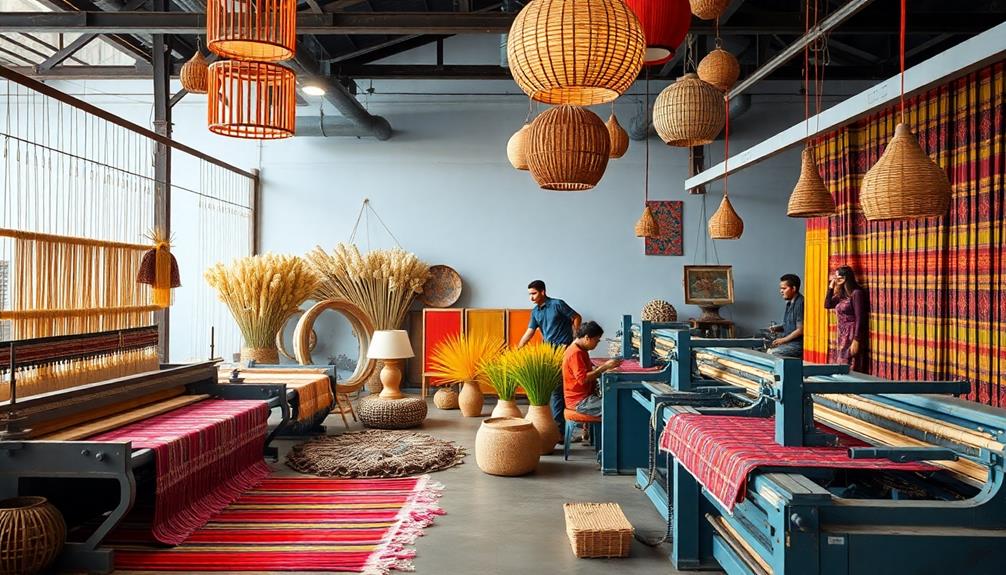
You'll find that the Indonesian textile industry faces significant hurdles in modernizing due to rising production costs and outdated machinery.
As traditional practices and materials are increasingly replaced by modern methods, the tension between traditional and modern housing styles reflects a broader challenge in the cultural landscape.
With 70-80% of equipment over 25 years old, efficiency is suffering, making it tough to compete globally.
As competitors in countries like Vietnam and China continue to innovate and lower costs, the pressure is on for Indonesian manufacturers to adapt swiftly.
Rising Production Costs
In recent years, the textile industry in Indonesia has faced significant challenges due to rising production costs. These costs have been driven by escalating energy prices and increasing labor expenses, which severely impact profitability.
Additionally, the demand for traditional artistry in decor, such as vibrant Indonesian textiles, adds pressure on manufacturers to balance quality with affordability. Despite the industry's impressive annual growth rate of 5.84%, stagnant export growth compared to competitors like Vietnam and Bangladesh makes it harder to stay competitive.
You might find the following factors contributing to these rising production costs:
- High energy prices affecting manufacturing expenses
- Increased labor costs that strain budgets
- An influx of cheaper textile imports challenging smaller manufacturers
- Outdated machinery that complicates technological advancements
These rising production costs not only threaten the profit margins of manufacturers but also hinder their ability to embrace necessary innovations and sustainability initiatives.
As a result, many are left scrambling to adapt to evolving consumer demands while managing financial constraints. The challenge lies in finding ways to modernize and maintain competitiveness in a rapidly changing market.
If the industry can tackle these issues head-on, it may reveal new opportunities for growth and innovation in the sector of modern decor.
Aging Machinery Issues
Facing the reality of aging machinery, many Indonesian textile manufacturers find themselves trapped in a cycle that stifles innovation and efficiency. With approximately 70-80% of their equipment over 25 years old, these manufacturers face significant hurdles in modernization efforts.
Aging machinery not only hampers production speed but also results in high operational costs. Outdated equipment is less energy-efficient, demanding more labor-intensive processes that cut into profit margins. Additionally, the use of traditional craftsmanship in textiles can be hindered by outdated processes, limiting the ability to blend modern aesthetics with cultural elements, which is essential in today's market for designs that resonate with consumers seeking a harmonious environment.
The lack of investment in modern technology creates further challenges, making it tough to meet the rising consumer demand for contemporary textile designs and quality. As you look around, it's clear that many domestic manufacturers struggle to keep pace with competitors from countries like Vietnam and Bangladesh, who benefit from modernized production facilities and lower operating costs.
To enhance competitiveness, it's essential for the industry to prioritize upgrading machinery and adopting new technologies. The government's Industry 4.0 initiative highlights the urgent need for this transformation.
Global Competition Pressure
As aging machinery continues to pose significant hurdles for Indonesian textile manufacturers, global competition only intensifies the pressure to modernize. Countries like Vietnam, Bangladesh, and China are ramping up their game, offering lower production costs that make it hard for you to maintain profitability.
With high energy and labor expenses, along with 70-80% of machinery over 25 years old, modernization becomes a challenging task. The need to embrace contemporary design principles, akin to those seen in tropical contemporary architecture, can inspire innovation in textiles, allowing for a blend of functionality and aesthetic appeal.
To stay competitive, you need to adapt continually. Here are some challenges you might face:
- Rising Production Costs: Energy and labor prices are climbing, straining budgets.
- Stagnant Export Growth: Despite a 5.84% annual growth rate, exports lag behind those of competing nations.
- Smaller Manufacturer Pressure: Domestic producers feel the squeeze from cheaper imports, pushing you to innovate.
- Government Initiatives: The Industry 4.0 initiative aims to elevate Indonesia's textiles but requires significant investment in technology.
To thrive, it's essential for you to embrace modernization, improving efficiency and quality. Only then can Indonesian textiles reclaim their spot on the global stage.
Technological Innovations

While many industries struggle to keep pace with technological advancements, the Indonesian textile sector is thriving by embracing automation and digital printing technologies. These technological innovations enhance production efficiency, allowing for the creation of intricate designs that perfectly align with modern decor aesthetics.
Additionally, the rise of sustainable practices in the textile industry reflects a broader trend in interior design, where eco-friendly and locally sourced materials are increasingly valued, similar to the approach taken by Mahallati Interiors in their luxury tropical designs. By integrating advanced software solutions like Manufacturing Execution Systems (MES) and Enterprise Resource Planning (ERP), manufacturers streamline operations and boost overall business performance.
The Indonesian government's Industry 4.0 initiative is a significant driver in this modernization effort, aiming to position the country as a leading global producer by 2030. Digitalization is a key strategy in this transformation, enabling designers to craft user-friendly and contemporary textile products that resonate with younger consumers and current home decor trends.
As the industry adopts these cutting-edge technologies, you're likely to see a wider array of innovative designs and efficient production methods that cater to your tastes. The focus on technological innovations not only enhances the quality and variety of textiles available but also guarantees that Indonesian textiles remain at the forefront of modern decor.
Embracing these advancements means you get to enjoy unique, high-quality textiles that elevate your living spaces.
Sustainability Initiatives
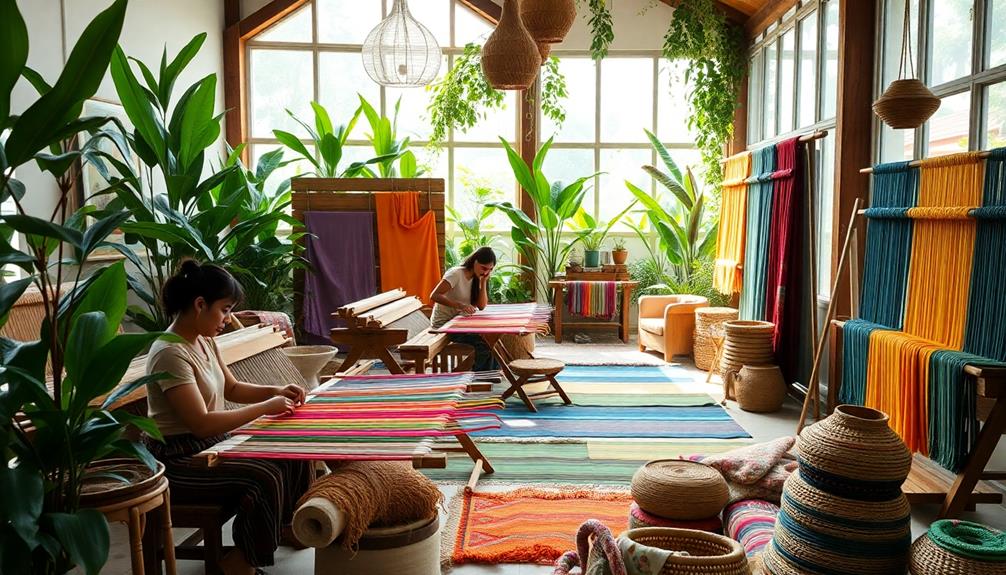
Sustainable practices are becoming a cornerstone of the Indonesian textile industry, as manufacturers increasingly adopt eco-friendly materials and processes.
These initiatives not only align with global sustainability trends but also aim to minimize the environmental impact of textile production.
You'll find a growing emphasis on using natural dyes and organic fibers that reduce chemical usage and promote healthier ecosystems.
Additionally, the incorporation of traditional batik patterns in modern decor reflects a commitment to preserving cultural heritage while embracing sustainability traditional batik patterns.
Key sustainability initiatives in the industry include:
- Promoting fair trade practices that support local artisans and preserve cultural heritage.
- Integrating advanced technologies encouraged by the government's Industry 4.0 initiative to enhance resource efficiency.
- Showcasing collections that blend traditional craftsmanship with modern sustainable design principles at events like Ethnic on the Go.
- Focusing on eco-friendly materials that align with consumer demand for sustainable products.
Global Market Expansion

The Indonesian textile industry is poised for remarkable growth in the global market, with exports valued at an impressive USD 12 billion in 2022. This strong foundation sets the stage for an exciting trajectory, as the industry is projected to grow from USD 13.83 billion in 2024 to USD 18.10 billion by 2029.
You'll see that the demand for Indonesian textiles is on the rise, reflecting expanding opportunities in global decor markets.
Strategic expansion efforts are underway to enhance Indonesia's presence on the global stage, particularly in key international markets like the US, EU, and the Middle East. By focusing on cultural strengths, Indonesian brands aim to capture niche segments that appreciate unique, handcrafted textiles.
The domestic middle class's growth is also driving increased consumer demand for traditional textiles, which aligns perfectly with modern decor trends.
Brands like Oerip are leading the charge, modernizing traditional fabrics and selling them in 13 countries. This showcases how versatile and appealing Indonesian textiles can be, seamlessly integrating into contemporary decor contexts.
It's an exciting time for the global market, and Indonesian textiles are undeniably at the forefront of this revolution.
The Appeal of Traditional Fabrics

With their intricate patterns and vibrant colors, traditional Indonesian textiles like Batik, Ikat, and Songket make striking statement pieces in modern decor.
These traditional fabrics not only add aesthetic value but also carry rich cultural narratives that resonate with many. Their unique designs and colors reflect Indonesia's diverse heritage, allowing you to create a space that tells a story.
Incorporating traditional fabrics into your decor comes with several appealing benefits:
- Cultural Significance: Each piece showcases Indonesia's artistry and craftsmanship.
- Sustainability: Many of these textiles are eco-friendly, aligning with modern trends that prioritize sustainability.
- Versatility: They can be integrated into various decor styles, from minimalist to bohemian.
- Connection to Heritage: Using these fabrics allows you to celebrate and honor cultural traditions.
As the textile industry continues to grow, the demand for traditional fabrics in modern decor is on the rise.
Events like Ethnic on the Go highlight their appeal to younger generations, showcasing how these textiles can blend cultural significance with contemporary style.
Embrace the charm of traditional Indonesian textiles and transform your space today.
Case Studies of Successful Brands

Many brands are successfully harnessing the beauty of traditional Indonesian textiles while appealing to modern aesthetics. These brands showcase the cultural richness of Indonesian fabrics, transforming them into stylish and sustainable products for today's consumers.
Here's a closer look at some successful brands:
| Brand | Focus Area | Unique Selling Proposition |
|---|---|---|
| Oerip | Fashion | Affordable garments with batik and ikat |
| Mufit | Sustainable Decor | Eco-friendly materials with innovative design |
| Nduk | Home Decor | Artisanal products highlighting cultural significance |
| Metty | Textile Accessories | Reviving ancient techniques for modern use |
| Soekirman | Interior Design | Versatile textiles enhancing modern aesthetics |
These brands exemplify how traditional textiles can remain relevant by blending heritage with contemporary design. Oerip's expansion to 13 countries proves that the youth appreciate cultural richness when it's presented stylishly. Mufit's sustainable practices attract eco-conscious consumers, while Nduk emphasizes the importance of heritage through unique decor items. Metty and Soekirman further demonstrate the versatility of Indonesian textiles in both fashion and home environments.
Future Trends in Decor
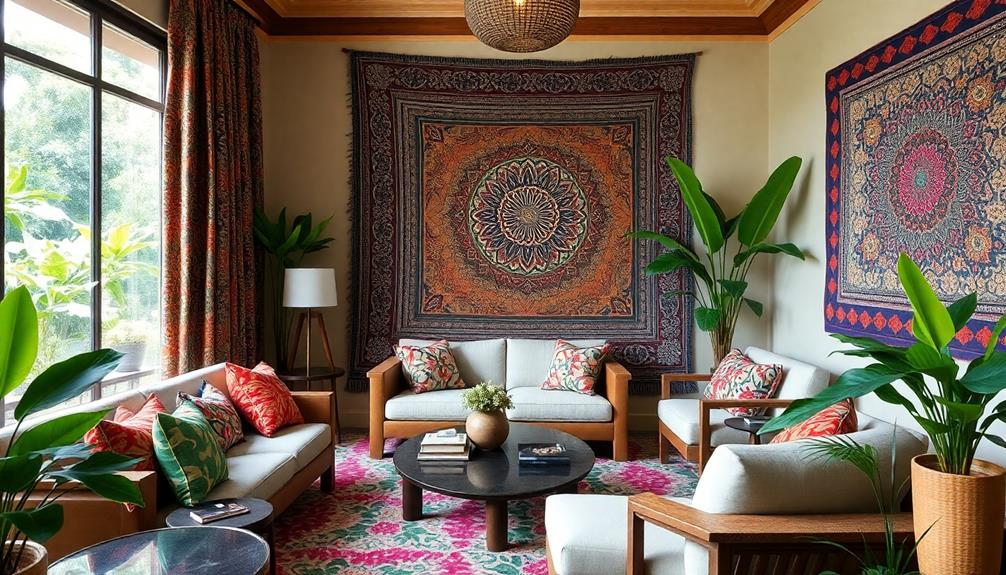
As Indonesia's textile industry continues to flourish, it's shaping the future of modern decor in exciting ways. You can expect to see a blend of traditional craftsmanship and contemporary design that resonates with a growing audience. In addition to the traditional craftsmanship, Indonesia’s textile industry also focuses on integrating technology into traditional decor. This blend of old and new techniques results in innovative products that appeal to both domestic and international markets. From smart textiles to digitally enhanced patterns, the industry is redefining modern decor with a unique Indonesian touch.
As younger consumers increasingly value unique, culturally-rich decor, Indonesian textiles are set to thrive. Here are some key trends to watch for:
- Cultural Fusion: Designers will combine Batik, Ikat, and Songket techniques with modern aesthetics, creating vibrant decor pieces.
- Technological Integration: Advances in digital printing will allow for innovative patterns, maintaining the cultural essence while appealing to modern tastes.
- Sustainability Focus: Expect a rise in eco-friendly materials and production practices, aligning with consumers' desire for socially responsible decor.
- Global Recognition: Indonesian textiles will gain traction in niche markets, such as modest fashion, influencing home decor offerings.
Frequently Asked Questions
What Is the Indonesian Textile Technique?
Indonesian textile techniques include Batik, Ikat, and Songket. You'll appreciate Batik's intricate designs, Ikat's blurred patterns, and Songket's luxurious threads. Each method showcases cultural heritage while appealing to modern aesthetics in design.
What Is the Outlook for the Textile Industry in Indonesia in 2024?
The outlook for Indonesia's textile industry in 2024 looks promising. You'll see it grow to USD 13.83 billion, benefiting from a 5.84% growth rate and strong export values, ensuring significant employment opportunities for many.
What Is the Fabric Design of Indonesia?
Indonesia's fabric design boasts rich traditions like Batik, Ikat, and Songket. Each pattern tells a story, showcasing the country's diverse cultures. You'll find vibrant colors and intricate techniques that truly reflect Indonesia's artistic heritage.
What Is the Most Famous Textile of Indonesia?
The most famous textile of Indonesia is Batik. You'll find its intricate patterns and wax-resist dyeing technique enchanting. Celebrated for its cultural significance, Batik reflects Indonesia's rich heritage and diverse narratives beautifully.
Conclusion
As you embrace Indonesian textiles, you're not just decorating; you're weaving stories of heritage and innovation. The vibrant patterns contrast with sleek modern lines, creating a harmonious blend of past and present. While sustainability initiatives breathe new life into traditional practices, the global market expansion showcases their growing allure. By choosing these fabrics, you're supporting artisans and celebrating craftsmanship, ensuring that the beauty of Indonesia's textiles continues to transform spaces and inspire generations to come.
